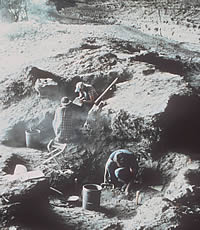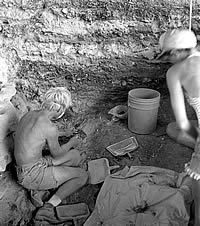Areas B and E
When archeologists first began work at Hinds Cave they observed numerous coprolites the looter backdirt piles along the southwest wall of the shelter. Intact deposits were visible in the walls of looter holes and it could be seen that a sizable area of undisturbed deposits remained. Area B was excavated to expose latrine deposits and collect coprolites and associated materials. This area proved to be the most informative of any at Hinds Cave, in part because of the nature of the deposits and due to the careful excavation and sampling methods followed in Area B. Glenda W. Dean supervised the work here and took copious notes while Ed Baxter did most of the digging.
The work began here in 1975. First, the walls of a deep looter hole were cleaned up and cut back to provide a stratigraphic exposure (Unit B1). Two coprolite lenses were observed and it was decided to isolate a block measuring 1.5-x-1.5 m. Next a sequence of five small narrow units (Units B2-B6) were dug on three sides, with the rear wall of the shelter forming the fourth side of the Area B Block (or Block B.)
Using the natural stratigraphy (visible layers) exposed on three sides, the excavators peeled back layer after layer of the Block B deposits. These layers, termed lenses, were numbered sequentially from the top. The intact deposits were systematically excavated and removed to a depth of just over a meter below the surface by the end of the 1975 season. Massive lenses of coprolites and urine-compacted soil had been encountered—these represent an obvious long-term latrine location against the rear wall of the shelter. The thickest and lowest lens reached in 1975 was designated B-13. In 1976, the Area B excavations continued, reaching a depth of 2.0 to 2.5 m below the original shelter surface. Additional latrine layers were encountered and sampled in the lower section of Block B.
Immediately south of Area B, a 1.25-x-1.5 m unit was excavated in 1975 and designated Area E. Areas B and E were connected with a small unit dubbed Trench B-E that ran along the rear wall of the shelter. Additional latrine and midden lenses were encountered in the Area E and B-E excavations, adding to the sample of stratified coprolite lenses found in Area B.
For purposes of discussion and analyses of grouped data (such as Lord’s faunal study) Units/Areas B, E and B-E are often considered together. The stratigraphic record of “greater” Area B is the most complete of any area at Hinds Cave because intact upper deposits were present. Good samples were obtained from almost all of the Analysis Units (except AU 6). The stratified latrine deposits have proven extremely important. Dean analyzed a large sample of the Lens 13 coprolites for her dissertation study and Stock included coprolites from deeper Area B lenses in her work. The calibrated midpoints of the 15 radiocarbon dates obtained from Area B samples range from about 200 B.C. to 6100 B.C.


